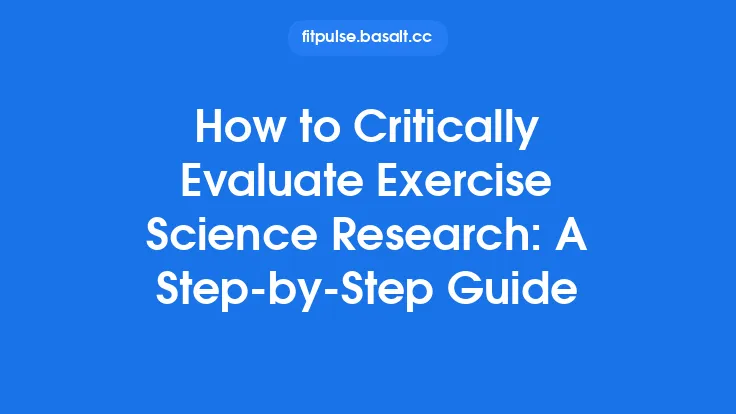Choosing the right exercise science certification is a pivotal step for anyone serious about building a credible, effective, and sustainable career in the health‑and‑fitness industry. With a multitude of certifying bodies, specialty tracks, and varying eligibility requirements, the decision can feel overwhelming. This guide walks you through the essential considerations, decision‑making tools, and practical steps you need to evaluate each option against your personal and professional objectives. By the end, you’ll have a clear roadmap for selecting a certification that aligns with your expertise, target clientele, and long‑term aspirations.
Understanding the Landscape of Exercise Science Certifications
Exercise science certifications are credentialing programs that validate a professional’s knowledge and competence in applying scientific principles to human movement, performance, and health. While the market offers dozens of options, they generally fall into three broad categories:
| Category | Typical Focus | Common Credential Types |
|---|---|---|
| Generalist | Foundational anatomy, physiology, biomechanics, and program design for a wide audience. | Certified Personal Trainer, Certified Exercise Specialist |
| Performance‑Oriented | Strength and power development, sport‑specific conditioning, and advanced training methodologies. | Strength & Conditioning Specialist, Performance Coach |
| Clinical/Health‑Focused | Exercise prescription for disease management, rehabilitation, and health promotion. | Clinical Exercise Specialist, Exercise Physiologist |
Each category serves distinct client populations and career pathways. Understanding where your interests lie—whether you aim to work in a commercial gym, a sports performance lab, a clinical setting, or a corporate wellness program—helps narrow the field early in the selection process.
Assessing Your Professional Goals and Target Population
Before diving into specific credentials, clarify the following questions:
- Who will you serve?
- General public seeking fitness improvement?
- Athletes competing at collegiate, professional, or amateur levels?
- Patients with chronic conditions (e.g., cardiovascular disease, diabetes, orthopedic injuries)?
- What scope of practice do you envision?
- Designing individualized workout plans?
- Conducting functional movement assessments?
- Leading group classes, workshops, or seminars?
- Where do you see your career in 5–10 years?
- Managing a fitness facility?
- Consulting for sports teams?
- Conducting research or teaching in an academic setting?
Your answers will guide you toward certifications that emphasize the knowledge domains most relevant to your intended practice.
Evaluating Accreditation and Credibility of Certification Bodies
A certification’s value hinges on the credibility of the organization that issues it. While you should avoid a deep dive into the “differences between major certifying agencies” (a topic covered elsewhere), there are universal markers of legitimacy you can assess:
- Recognition by Professional Associations: Look for endorsements or listings on the websites of reputable bodies such as the American College of Sports Medicine (ACSM), National Strength and Conditioning Association (NSCA), or International Society of Sports Nutrition (ISSN). Even if you’re not comparing them directly, their acknowledgment signals industry acceptance.
- Alignment with International Standards: Many reputable certifications align their curricula with the International Standards for Certified Exercise Professionals (ISCEP) or the World Health Organization’s (WHO) guidelines for physical activity. This alignment ensures that the content reflects current scientific consensus.
- Transparent Governance: Credible organizations publish clear policies on exam development, conflict‑of‑interest safeguards, and periodic content reviews by subject‑matter experts.
- Third‑Party Audits: Some certifying bodies undergo external audits (e.g., ISO 9001 certification) to verify the quality and consistency of their processes.
When a certification meets these criteria, employers, insurers, and clients are more likely to view it as a trustworthy indicator of competence.
Comparing Core Content Areas and Competency Frameworks
Even within the same category, certifications can differ substantially in the depth and breadth of topics covered. Examine the competency framework or exam blueprint provided by each program. Key content domains to evaluate include:
- Anatomy & Physiology: Depth of coverage on musculoskeletal, cardiovascular, and metabolic systems.
- Biomechanics & Kinesiology: Understanding of movement analysis, joint mechanics, and force production.
- Exercise Prescription: Ability to design periodized programs, manipulate variables (intensity, volume, frequency), and apply progressive overload principles.
- Nutrition Fundamentals: Basic principles of macronutrients, hydration, and timing as they relate to performance and health.
- Behavior Change & Coaching: Strategies for client motivation, adherence, and psychological support.
- Safety & Risk Management: Knowledge of injury prevention, emergency protocols, and legal considerations (e.g., liability waivers).
A certification that offers a comprehensive, science‑driven curriculum will better equip you to adapt to diverse client needs and emerging research.
Considering Prerequisites, Eligibility, and Exam Format
Each certification sets its own entry requirements. Common prerequisites include:
- Educational Background: High school diploma, associate’s degree, or bachelor’s degree in exercise science, kinesiology, or a related field.
- Professional Experience: Minimum hours of practical experience (e.g., 500‑1,000 client contact hours).
- CPR/AED Certification: Many programs require current cardiopulmonary resuscitation certification.
Assess whether you meet these criteria or if you need to acquire additional qualifications first.
Exam Format also influences your preparation strategy:
- Computer‑Based Testing (CBT): Typically multiple‑choice, adaptive testing with immediate scoring.
- Paper‑Based Testing: May involve longer response formats, such as case studies or short essays.
- Practical/Performance Assessments: Some certifications include a hands‑on component where you demonstrate skill execution.
Choose a format that aligns with your learning style and logistical preferences (e.g., ability to travel to a testing center versus taking an online proctored exam).
Analyzing Cost, Time Investment, and Delivery Modalities
Financial and temporal commitments vary widely:
| Factor | Typical Range | Considerations |
|---|---|---|
| Exam Fee | $150 – $500 | Includes retake policies? |
| Study Materials | $100 – $400 | Bundled packages vs. à la carte resources |
| Recertification (if applicable) | $100 – $300 (every 2–4 years) | Not the focus here, but note future budgeting |
| Study Time | 100 – 300 hours | Depends on prior knowledge and format |
| Delivery Mode | Self‑paced online, live virtual classrooms, in‑person workshops | Flexibility vs. structured learning environment |
When budgeting, factor in ancillary costs such as CPR certification renewal, travel for testing, and any required equipment for practical assessments.
Weighing Industry Recognition and Employer Preferences
Even if a certification meets academic standards, its market value can differ based on regional employer preferences. Conduct targeted research:
- Job Listings: Scan postings in your desired geographic area or sector. Note which credentials are repeatedly requested.
- Professional Networks: Engage with mentors, alumni groups, or industry forums to learn which certifications are most respected among peers.
- Facility Policies: Some gyms or health clubs have preferred vendor relationships with specific certifying bodies.
A credential that aligns with employer expectations can accelerate job placement and salary negotiations.
Specialization Options and Niche Certifications
If you have a clear niche—such as youth fitness, senior health, corrective exercise, or sport‑specific conditioning—consider certifications that offer dedicated specialty modules or endorsements. Benefits include:
- Targeted Knowledge: Deep dives into population‑specific considerations (e.g., age‑related physiological changes, sport‑specific injury patterns).
- Differentiation: Ability to market yourself as an expert in a high‑demand sub‑field.
- Continuity: Many generalist certifications allow you to add specialty credentials later, providing a scalable pathway.
Ensure that any specialty track is built upon a solid foundational certification to maintain credibility.
Geographic and Legal Considerations
Regulatory environments differ across states, provinces, and countries. Some jurisdictions require specific licensure (e.g., “Exercise Physiologist” licensure in certain Canadian provinces) or restrict the scope of practice for non‑licensed trainers. To avoid legal pitfalls:
- Check Local Regulations: Verify whether the certification you’re considering satisfies any statutory requirements for the region where you intend to practice.
- Insurance Compatibility: Confirm that professional liability insurers recognize the credential for coverage purposes.
- Cross‑Border Validity: If you anticipate relocating, select a certification with international recognition or reciprocal agreements.
Making an Informed Decision: A Step‑by‑Step Checklist
- Define Your Target Clientele and Career Path
Write a concise statement summarizing who you want to serve and where you see yourself working.
- List Potential Certifications
Compile at least three options that appear to match your goals.
- Compare Core Content
Use the competency frameworks to score each certification on relevance to your target population (e.g., 1–5 scale).
- Verify Credibility
Check for accreditation, alignment with international standards, and transparent governance.
- Assess Eligibility
Confirm you meet prerequisites or outline steps needed to become eligible.
- Evaluate Logistics
Compare costs, required study hours, exam format, and delivery mode.
- Research Market Demand
Scan job ads and network feedback for employer preference data.
- Consider Future Flexibility
Determine whether the certification allows for specialty add‑ons or advanced credentials.
- Make a Decision Matrix
Assign weighted scores to each factor based on personal priority (e.g., cost 20%, content relevance 30%, employer demand 25%, etc.) and calculate a total score.
- Plan Your Path Forward
Set a timeline for enrollment, study milestones, and exam registration.
Closing Thoughts
Selecting the right exercise science certification is not a one‑size‑fits‑all process; it requires a strategic blend of self‑assessment, market research, and practical considerations. By systematically evaluating the credibility of certifying bodies, aligning curriculum content with your professional objectives, and factoring in logistical realities, you can choose a credential that not only validates your expertise but also opens doors to the career trajectory you envision. Remember, the certification is a foundation—continuous learning, hands‑on experience, and a commitment to evidence‑based practice will ultimately define your success in the dynamic field of exercise science.




